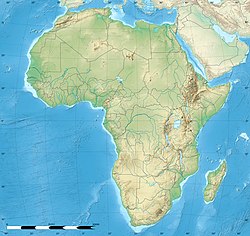Asmara
Asmara
ኣስመራ Asmera | |
|---|---|
 | |
| Coordinates: 15°19′22″N 38°55′30″E / 15.32278°N 38.92500°E | |
| Country | Eritrea |
| Region | Central |
| Districts | 13 |
| Demonym | Asmarino |
| Government | |
| • Mayor of Asmara | Semere Russom |
| • Mayor of Zoba | Tewelde Kelati |
| Area | |
| • Capital | 45 km2 (17 sq mi) |
| Elevation | 2,325 m (7,628 ft) |
| Population (2017)[1] | |
| • Capital | 804,000 |
| • Density | 17,867/km2 (46,280/sq mi) |
| • Metro | 1,258,001 |
| Time zone | UTC+3 (EAT) |
| Climate | BSk |
| Official name | Asmara: a Modernist City of Africa |
| Criteria | Cultural: ii, iv |
| Reference | 1550 |
| Inscription | 2017 (41st Session) |
| Area | 481 ha |
| Buffer zone | 1,203 ha |
Asmara is the capital city of Eritrea. It is the largest settlement in the country. Asmara has a population of about 579,000 people. Textiles and clothing, meat, beer, shoes, and ceramics are the major industrial products of the city.
History
[change | change source]Asmara grew from four villages founded in the twelfth century. It is said that there were four clans living in the Asmara area. The women of these tribes told them men to join together to fight bandits who had been attacking the area. After they defeated the bandits, a new name was given to the place, Arbaete Asmara. This name, in the Tigrinya language, meant the four females united. Arbaete was later dropped and the name was made Asmara.
In 1889, Asmara became an Italian colony. It was made the capital of the country in 1897 and was called Asmara italiana. The city was damaged during earthquakes in 1913 and 1915. During the 1930s, the Italians made many chances to how Asmara looked. Many new buildings were created during this time and the city was mainly populated by Italian colonists (in 1940 there were 57000 Italian residents on a total population of 98000).[2]
These buildings were built in the same style as Italian buildings. This gave Asmara the look of an Italian city. Today many of the buildings and stores in Asmara still have Italian names.
During World War II, after the defeat of Italy in Africa, Asmara was under British rule. In 1952, the United Nations placed the country and Asmara under Ethiopian control. In the 1960s, the Eritrean people started fighting for independence from Ethiopia.
This bloody war lasted until 1991. Asmara was given back to the Eritrean people on May 24, 1991.
In July 2017 Asmara has been declared World Heritage Site by the UNESCO.
Asmara is a new addition (since July 2017) to the UNESCO's World Heritage Sites, under the direction of the "Cultural Assets Rehabilitation Project", for its outstanding examples of 20th century architecture and town planning when was called 'Asmara italiana'........Asmara, a village that became the capital in 1891, still conserves an almost intact urban structure and architectural features from its half century of colonialism. The first expansion of Asmara was regulated by a scheme plan, approved in 1902, which included the area to the East of the original military outpost on the Mai Belà river. The grid pattern was marked by two major arteries, parallel to each other: the King’s Way (il Corso del Re) and the Queen’s Avenue (il Viale della Regina). After the space of a decade, Cavagnari’s plan was the first to separate the European settlement from the indigenous zone. The advent of Fascism did not have an immediate impact in Eritrea; by then the capital had developed a well-integrated population. One is continuously surprised by testimonies of the residents in Asmara in the Thirties, which express a state of mind shared by both colonizers and colonized, describing the city as: ‘beautiful [...] inhabited by a mixed race, Italians and Africans ... a lot of traffic, shops, cinemas and restaurants...’ . It is commonplace to refer to ‘good Italian people’ (italiani brava gente), which is a most difficult viewpoint to abandon, and is also a most relevant perspective when considering the architectural patrimony of Asmara as a shared heritage. M. Casciato, University of Bologna
Related pages
[change | change source]References
[change | change source]- ↑ "CIA - The World Factbook". Archived from the original on 15 May 2020. Retrieved 2 September 2012.
- ↑ Asmara colonia italiana e oltre (in Italian)
Bibliography
[change | change source]- Francesca Calace. Restituiamo la Storia – dagli archivi ai territori. Architetture e modelli urbani nel Mediterraneo orientale Gangemi editorial Rome, 2012 ISBN 978-88-492-2364-4
- Giovanni Godoli. Asmara: immagine di una città. Architettura e Potere da Ferdinando Martini all'Impero. Universita' di Firenze. Florence, 2012 ([1])
- Jochen Visscher. Asmara - The Frozen City Jovis ed. Berlin, 2006 ISBN 978-3-936314-61-8 ([2])

